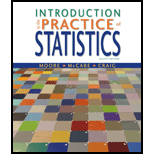
(a)
To find: The variables IBI and area using numerical method.
(a)
Answer to Problem 32E
Solution: The obtained result can be shown in tabular form as follows:
Variable |
Mean |
Standard deviation |
Area |
28.29 |
17.71 |
IBI |
65.94 |
18.28 |
Explanation of Solution
Calculation: Calculate the average and standard deviation of IBI and area using Minitab as follows:
Step 1: Enter the data in Minitab.
Step 2: Click on Stat --> Basic statistics --> Display
Step 3: Double click on “Area” and “IBI” to move it to variables column.
Step 4: Click on “Statistics” and check the box for mean and standard deviation.
Step 5: Click “OK” twice to obtain the result.
Results are obtained as
Variable |
Mean |
Standard deviation |
Area |
28.29 |
17.71 |
IBI |
65.94 |
18.28 |
To find: The variables IBI and area using graphical method.
Answer to Problem 32E
Solution: The graph of “Area” is slightly right skewed and the graph of “IBI” is left skewed.
Explanation of Solution
Graph: Construct the histograms to check the skewness using Minitab as follows:
Step 1: Go to Graphs > Histogram > Simple histogram.
Step 2: Double click on “Area” and “IBI” to move it to variables column.
Step 3: Click “OK” to obtain the result.
The graph is obtained as
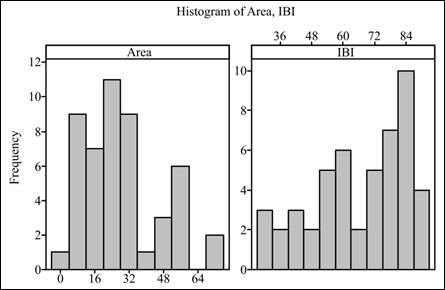
Interpretation: The graph of area is slightly right skewed and the graph of IBI is left skewed.
(b)
To graph: A
(b)
Explanation of Solution
Graph: Construct a scatter plot as follows:
Step 1: Enter the data in Minitab.
Step 2: Click on Graph --> Scatterplot. Select scatterplot with regression.
Step 3: Double click on “IBI” to move it Y variable and “Area” to move it to X variable column.
Step 4: Click “OK” twice to obtain the graph.
The scatter plot is obtained as
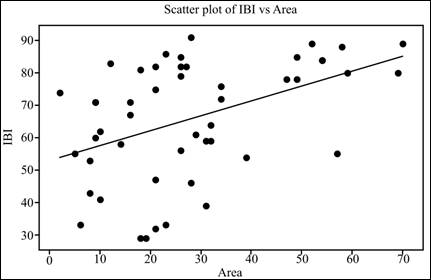
Interpretation: The graph shows weak linear relationship between IBI and Area with no unusual activity.
(c)
To explain: The statistical model for simple linear regression.
(c)
Answer to Problem 32E
Solution: The model is
Explanation of Solution
where
(d)
To explain: The null and alternate hypotheses.
(d)
Answer to Problem 32E
Solution: The null and alternative hypotheses are
Explanation of Solution
So, the null and alternative hypotheses can be stated as
(e)
To test: The least square
(e)
Answer to Problem 32E
Solution: The obtained output represents that the P-value is less than 0.05. So there is enough evidence for the linearity in the regression line.
Explanation of Solution
Calculation: Obtain the regression line using Minitab as follows:
Step 1: Enter the data in Minitab.
Step 2: Click on Stat --> Regression --> Regression.
Step 3: Double click on “IBI” to move it response column and “Area” to move it to predictor column.
Step 4: Click “OK” to obtain the result.
The results are obtained.
Conclusion: From the obtained output, the value of test statistic is 3.42 and the P-value is 0.001. Since the P-value is less than the significance level 0.05, it can be concluded that there is enough evidence for the linearity in the regression line.
(f)
To find: The residuals.
(f)
Answer to Problem 32E
Solution: The residuals are as follows:
Area |
IBI |
Residuals |
21 |
47 |
–15.5862 |
34 |
76 |
7.4318 |
6 |
33 |
–22.6839 |
47 |
78 |
3.4497 |
10 |
62 |
4.4755 |
49 |
78 |
2.5294 |
23 |
33 |
–30.5065 |
32 |
64 |
–3.6479 |
12 |
83 |
24.5552 |
16 |
67 |
6.7146 |
29 |
61 |
–5.2675 |
49 |
85 |
9.5294 |
28 |
46 |
–19.8073 |
8 |
53 |
–3.6042 |
57 |
55 |
–24.1518 |
9 |
71 |
13.9356 |
31 |
59 |
–8.1878 |
10 |
41 |
–16.5245 |
21 |
82 |
19.4138 |
26 |
56 |
–8.8870 |
31 |
39 |
–28.1878 |
52 |
89 |
12.1490 |
21 |
32 |
–30.5862 |
8 |
43 |
–13.6042 |
18 |
29 |
–32.2058 |
5 |
55 |
–0.2237 |
18 |
81 |
19.7942 |
26 |
82 |
17.1130 |
27 |
82 |
16.6529 |
26 |
85 |
20.1130 |
32 |
59 |
–8.6479 |
2 |
74 |
20.1567 |
59 |
80 |
–0.0721 |
58 |
88 |
8.3880 |
19 |
29 |
–32.6659 |
14 |
58 |
–1.3651 |
16 |
71 |
10.7146 |
9 |
60 |
2.9356 |
23 |
86 |
22.4935 |
28 |
91 |
25.1927 |
34 |
72 |
3.4318 |
70 |
89 |
3.8662 |
69 |
80 |
–4.6737 |
54 |
84 |
6.2287 |
39 |
54 |
–16.8690 |
9 |
71 |
13.9356 |
21 |
75 |
12.4138 |
54 |
84 |
6.2287 |
26 |
79 |
14.1130 |
Explanation of Solution
Calculation: Obtain the regression line using Minitab as follows:
Step 1: Enter the data in Minitab.
Step 2: Click on Stat --> Regression --> Regression.
Step 3: Double click on “IBI” to move it to response column and “Area” to move it to predictor column.
Step 4: Click on “Storage” and check the box for residuals.
Step 5: Click “OK” twice to obtain the result.
To graph: The scatterplot.
Explanation of Solution
Graph: Construct a scatterplot using Minitab as follows:
Step 1: Enter the data in Minitab.
Step 2: Click on Graph --> Scatterplot. Select scatterplot with regression.
Step 3: Double click on “Area” to move it X variable and “Residuals” to move it to Y variable column.
Step 4: Click “OK” to obtain the graph.
The scatter plot is obtained as
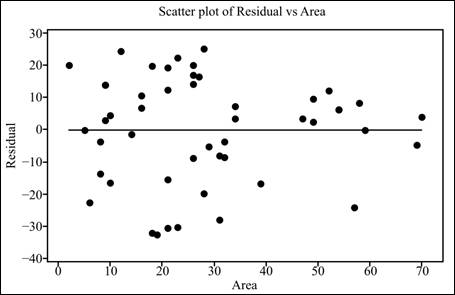
Interpretation: The graph shows that there is more variation for small
Whether there is something unusual.
Answer to Problem 32E
Solution: No, there is nothing unusual.
Explanation of Solution
(g)
That residuals are normal or not.
(g)
Answer to Problem 32E
Solution: The residuals are
Explanation of Solution
Step 1: Click on Stat --> Descriptive statistics --> Normality test.
Step 2: Double click on “Residuals” to move it to the variable column.
Step 3: Click “OK” to obtain the graph.
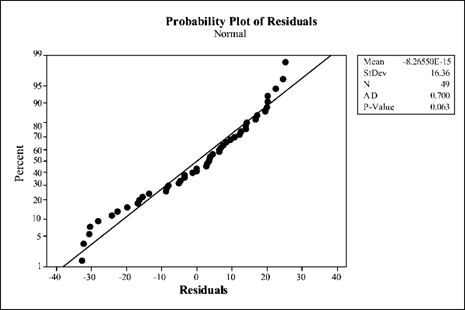
Conclusion: All the points lie near the trend line and there are no outliers. Therefore, it can be concluded that residuals are normally distributed.
(h)
If the assumptions of statistical inference are satisfied or not.
(h)
Answer to Problem 32E
Solution: The assumptions are satisfied.
Explanation of Solution
Want to see more full solutions like this?
Chapter 10 Solutions
Introduction to the Practice of Statistics: w/CrunchIt/EESEE Access Card
- If a uniform distribution is defined over the interval from 6 to 10, then answer the followings: What is the mean of this uniform distribution? Show that the probability of any value between 6 and 10 is equal to 1.0 Find the probability of a value more than 7. Find the probability of a value between 7 and 9. The closing price of Schnur Sporting Goods Inc. common stock is uniformly distributed between $20 and $30 per share. What is the probability that the stock price will be: More than $27? Less than or equal to $24? The April rainfall in Flagstaff, Arizona, follows a uniform distribution between 0.5 and 3.00 inches. What is the mean amount of rainfall for the month? What is the probability of less than an inch of rain for the month? What is the probability of exactly 1.00 inch of rain? What is the probability of more than 1.50 inches of rain for the month? The best way to solve this problem is begin by a step by step creating a chart. Clearly mark the range, identifying the…arrow_forwardClient 1 Weight before diet (pounds) Weight after diet (pounds) 128 120 2 131 123 3 140 141 4 178 170 5 121 118 6 136 136 7 118 121 8 136 127arrow_forwardClient 1 Weight before diet (pounds) Weight after diet (pounds) 128 120 2 131 123 3 140 141 4 178 170 5 121 118 6 136 136 7 118 121 8 136 127 a) Determine the mean change in patient weight from before to after the diet (after – before). What is the 95% confidence interval of this mean difference?arrow_forward
- In order to find probability, you can use this formula in Microsoft Excel: The best way to understand and solve these problems is by first drawing a bell curve and marking key points such as x, the mean, and the areas of interest. Once marked on the bell curve, figure out what calculations are needed to find the area of interest. =NORM.DIST(x, Mean, Standard Dev., TRUE). When the question mentions “greater than” you may have to subtract your answer from 1. When the question mentions “between (two values)”, you need to do separate calculation for both values and then subtract their results to get the answer. 1. Compute the probability of a value between 44.0 and 55.0. (The question requires finding probability value between 44 and 55. Solve it in 3 steps. In the first step, use the above formula and x = 44, calculate probability value. In the second step repeat the first step with the only difference that x=55. In the third step, subtract the answer of the first part from the…arrow_forwardIf a uniform distribution is defined over the interval from 6 to 10, then answer the followings: What is the mean of this uniform distribution? Show that the probability of any value between 6 and 10 is equal to 1.0 Find the probability of a value more than 7. Find the probability of a value between 7 and 9. The closing price of Schnur Sporting Goods Inc. common stock is uniformly distributed between $20 and $30 per share. What is the probability that the stock price will be: More than $27? Less than or equal to $24? The April rainfall in Flagstaff, Arizona, follows a uniform distribution between 0.5 and 3.00 inches. What is the mean amount of rainfall for the month? What is the probability of less than an inch of rain for the month? What is the probability of exactly 1.00 inch of rain? What is the probability of more than 1.50 inches of rain for the month? The best way to solve this problem is begin by creating a chart. Clearly mark the range, identifying the lower and upper…arrow_forwardProblem 1: The mean hourly pay of an American Airlines flight attendant is normally distributed with a mean of 40 per hour and a standard deviation of 3.00 per hour. What is the probability that the hourly pay of a randomly selected flight attendant is: Between the mean and $45 per hour? More than $45 per hour? Less than $32 per hour? Problem 2: The mean of a normal probability distribution is 400 pounds. The standard deviation is 10 pounds. What is the area between 415 pounds and the mean of 400 pounds? What is the area between the mean and 395 pounds? What is the probability of randomly selecting a value less than 395 pounds? Problem 3: In New York State, the mean salary for high school teachers in 2022 was 81,410 with a standard deviation of 9,500. Only Alaska’s mean salary was higher. Assume New York’s state salaries follow a normal distribution. What percent of New York State high school teachers earn between 70,000 and 75,000? What percent of New York State high school…arrow_forward
- Pls help asaparrow_forwardSolve the following LP problem using the Extreme Point Theorem: Subject to: Maximize Z-6+4y 2+y≤8 2x + y ≤10 2,y20 Solve it using the graphical method. Guidelines for preparation for the teacher's questions: Understand the basics of Linear Programming (LP) 1. Know how to formulate an LP model. 2. Be able to identify decision variables, objective functions, and constraints. Be comfortable with graphical solutions 3. Know how to plot feasible regions and find extreme points. 4. Understand how constraints affect the solution space. Understand the Extreme Point Theorem 5. Know why solutions always occur at extreme points. 6. Be able to explain how optimization changes with different constraints. Think about real-world implications 7. Consider how removing or modifying constraints affects the solution. 8. Be prepared to explain why LP problems are used in business, economics, and operations research.arrow_forwardged the variance for group 1) Different groups of male stalk-eyed flies were raised on different diets: a high nutrient corn diet vs. a low nutrient cotton wool diet. Investigators wanted to see if diet quality influenced eye-stalk length. They obtained the following data: d Diet Sample Mean Eye-stalk Length Variance in Eye-stalk d size, n (mm) Length (mm²) Corn (group 1) 21 2.05 0.0558 Cotton (group 2) 24 1.54 0.0812 =205-1.54-05T a) Construct a 95% confidence interval for the difference in mean eye-stalk length between the two diets (e.g., use group 1 - group 2).arrow_forward
- An article in Business Week discussed the large spread between the federal funds rate and the average credit card rate. The table below is a frequency distribution of the credit card rate charged by the top 100 issuers. Credit Card Rates Credit Card Rate Frequency 18% -23% 19 17% -17.9% 16 16% -16.9% 31 15% -15.9% 26 14% -14.9% Copy Data 8 Step 1 of 2: Calculate the average credit card rate charged by the top 100 issuers based on the frequency distribution. Round your answer to two decimal places.arrow_forwardPlease could you check my answersarrow_forwardLet Y₁, Y2,, Yy be random variables from an Exponential distribution with unknown mean 0. Let Ô be the maximum likelihood estimates for 0. The probability density function of y; is given by P(Yi; 0) = 0, yi≥ 0. The maximum likelihood estimate is given as follows: Select one: = n Σ19 1 Σ19 n-1 Σ19: n² Σ1arrow_forward
 MATLAB: An Introduction with ApplicationsStatisticsISBN:9781119256830Author:Amos GilatPublisher:John Wiley & Sons Inc
MATLAB: An Introduction with ApplicationsStatisticsISBN:9781119256830Author:Amos GilatPublisher:John Wiley & Sons Inc Probability and Statistics for Engineering and th...StatisticsISBN:9781305251809Author:Jay L. DevorePublisher:Cengage Learning
Probability and Statistics for Engineering and th...StatisticsISBN:9781305251809Author:Jay L. DevorePublisher:Cengage Learning Statistics for The Behavioral Sciences (MindTap C...StatisticsISBN:9781305504912Author:Frederick J Gravetter, Larry B. WallnauPublisher:Cengage Learning
Statistics for The Behavioral Sciences (MindTap C...StatisticsISBN:9781305504912Author:Frederick J Gravetter, Larry B. WallnauPublisher:Cengage Learning Elementary Statistics: Picturing the World (7th E...StatisticsISBN:9780134683416Author:Ron Larson, Betsy FarberPublisher:PEARSON
Elementary Statistics: Picturing the World (7th E...StatisticsISBN:9780134683416Author:Ron Larson, Betsy FarberPublisher:PEARSON The Basic Practice of StatisticsStatisticsISBN:9781319042578Author:David S. Moore, William I. Notz, Michael A. FlignerPublisher:W. H. Freeman
The Basic Practice of StatisticsStatisticsISBN:9781319042578Author:David S. Moore, William I. Notz, Michael A. FlignerPublisher:W. H. Freeman Introduction to the Practice of StatisticsStatisticsISBN:9781319013387Author:David S. Moore, George P. McCabe, Bruce A. CraigPublisher:W. H. Freeman
Introduction to the Practice of StatisticsStatisticsISBN:9781319013387Author:David S. Moore, George P. McCabe, Bruce A. CraigPublisher:W. H. Freeman





